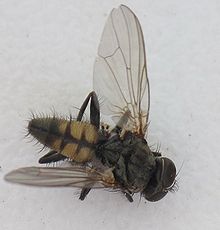- Lesser house fly
-
Lesser house fly Fannia canicularis male Scientific classification Kingdom: Animalia Phylum: Arthropoda Class: Insecta Order: Diptera Family: Fanniidae Genus: Fannia Species: F. canicularis Binomial name Fannia canicularis
(Linnaeus, 1761)Synonyms The lesser house fly or little house fly, Fannia canicularis, is somewhat smaller (3.5–6 millimetres or 0.14–0.24 inch) than the common housefly. It is slender, and the median vein in the wing is straight. Larvae feed on all manner of decaying organic matter, including carrion. It is the most common vector of myiasis within the Fanniidae.[1]
Contents
Morphology
Fannia canicularis is a slim fly reaching a length of from four to six millimetres. The white-bordered eyes meet above in the male a condition described as holoptic. In females the eyes do not meet together. The brown-grey thorax has three black longitudinal stripes in the males.These are much more indistinct in the female. The first two segments of the abdomen are translucently yellow with a dark-brown basal colour. The dark trapezoid marks of the males are hardly recognizable in the females. The halteres are yellowish.
Development
The females lay their eggs in in batches of up to 50 and may lay altogether up to 2,000 eggs. The eggs, which are white with a pair of dorsal longitudinal flanges or wings, and have the ability to float in liquid and semi-liquid decaying organic matter, especially poultry, cow and dog feces, kitchen wastes as the end of putrid potatoes or carrots, silage and compost, in addition, cheese, bacon and drying fish. They are commonly found in garbage depots, wheelie bins, garbage trucks and other places where food waste is stored. The eggs hatch after only 2 days (24 to 48 hours at 24–27 °C or 75–81 °F) and the larvae require 6 or more days to reach pupation, which lasts 7 or more days so that they usually take approx. 2–4 weeks to develop into adults, depending upon temperature repeating the live cycle again in very damp, putrid excrement, liquid manure, etc.
Behaviour
Fannia canicularis is spread world-wide and has a life expectancy from two to three weeks. In Central Europe approximately seven generations can develop per year. They are often found on excrement and on vertebrate animal. Because of their oscillating between excrement and human food the species is considered as possible disease carriers. From May to Octobers the small housefly comes frequently into buildings and is noticeable here by its peculiar, silent flight in the room center, where it circles down-hanging articles, particularly lamps. It changes the flight direction jerkily. This is a patrol flight, in which the males supervise if necessary their district and intruders attack. During short breaks and in the night hours the flies sit at lamps or on walls and leave there small excrement marks. In the wild tree branches serve the flies for their swarm dances.
Notes
- ^ Rozkosny, R.; Gregor, F.; Pont, A. C. (1997). The European Fanniidae (Diptera). Institute of Landscape Ecology. p. 80 pp.
References
- Steve, Peter C. (1960), "Biology and Control of the Little House Fly, Fannia canicularis, in Massachusetts", Journal of Economic Entomology 53 (6): 999–1004.
- Zeil, Jochen (1986), "The territorial flight of male houseflies (Fannia canicularis L.)", Behavioral Ecology and Sociobiology 19 (3): 213–219, doi:10.1007/BF00300862.
Categories:- Fanniidae
- Animals described in 1761
Wikimedia Foundation. 2010.

